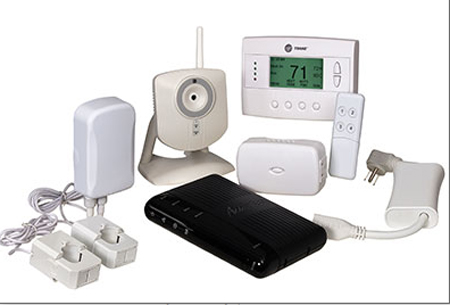By Steven Castle, GreenTech Advocates
Telecom giant Verizon has launched its long-anticipated Home Monitoring and Control system that offers remote control of web-based cameras, wireless thermostats, lights and appliance plug-in modules. Energy management and monitoring appear to be a big part of Verizon’s plans.
The company joins service providers ADT, Comcast/Xfinity, Alarm.com, Vivint and others in providing basic home control services. To date, the other service providers do not offer energy monitoring, so it will be very interesting how Verizon does with this offering—and whether other service providers follow. Verizon stresses that its “energy reader” monitor is a free offering valued at $99.

The Home Monitoring and Control system is now available to Verizon broadband customers for $9.99 per month, plus $70 to $220 for equipment kits required for three levels of service. For energy management, customers will have to spend $170 on equipment for the Energy Control Kit that includes a gateway, one smart wireless thermostat, one 110-volt appliance switch, one remote control and an energy reader that connects to the electrical panel to measure a home’s electricity consumption. Digital door locks, wireless door and window sensors and additional devices can be added.
Like other service provider offerings, control is available via smartphones, which many seem to like to operate thermostats remotely, either to turn set points down while they’re away from home or to crank up the air conditioning or heat before returning home. According to research firm Parks Associates, smartphone owners and those who have security systems are more likely to pay for energy management services.
Also like the other service provider offerings, Verizon’s system runs on the Z-Wave wireless mesh network. In addition to smartphone operation, the system can be controlled via a computer or through Verizon’s FiOS service on a TV. The gateway device will eventually enable Internet-based connections from Android or iOS tablets.
“With the help of Sigma’s Z-Wave technology, our broadband customers are now able to control their home’s energy usage and monitor their home environment regardless of whether they’re at home, in the office or on the road,” says Eric Bruno, vice president of product development for Verizon.
The system appears to be powered by the 4Home solution that was acquired by Motorola last year. Systems from ADT and Comcast/Xfinity are powered by the iControl platform. (iControl merged with uControl last year).
Good Positioning or Bad?
Verizon’s $9.99 per month subscription fee is the lowest among the big service providers, which typically charge about $30 and more for their services. That could be a selling point and a way to get more people interested in energy management, though some have expressed concern that selling energy management services will be a difficult prospect.
Such concerns may be valid at this early stage, but as energy prices increase and more and more people become aware of systems that can offer both convenience and energy savings, they will warm up to home energy management. The best way to educate the masses about these systems is to put them in front of people.
Verizon’s addition of the energy reader/monitor differentiates its offerings from the other service providers. And while it’s true that energy monitoring on its own has a limited lasting appeal—and should eventually be integrated with control systems to offer more automated energy savings—let’s remember that just having immediate feedback on energy usage inspires people to save 5 percent to 15 percent on their electricity bills. And including the energy reader in its offerings should both help to educate Verizon’s customers on the benefits of energy savings and inspire them to want to save more with Verizon’s systems.
Verizon may face an uphill climb in gaining traction with its energy management services, but the company has put itself in a good position. The other service providers should look to add more to their very limited energy management offerings as well.
![]() Editor’s Note: This news story comes to us as a cross post courtesy of GreenTech Advocates. Author credit for the post goes to Steven Castle.
Editor’s Note: This news story comes to us as a cross post courtesy of GreenTech Advocates. Author credit for the post goes to Steven Castle.